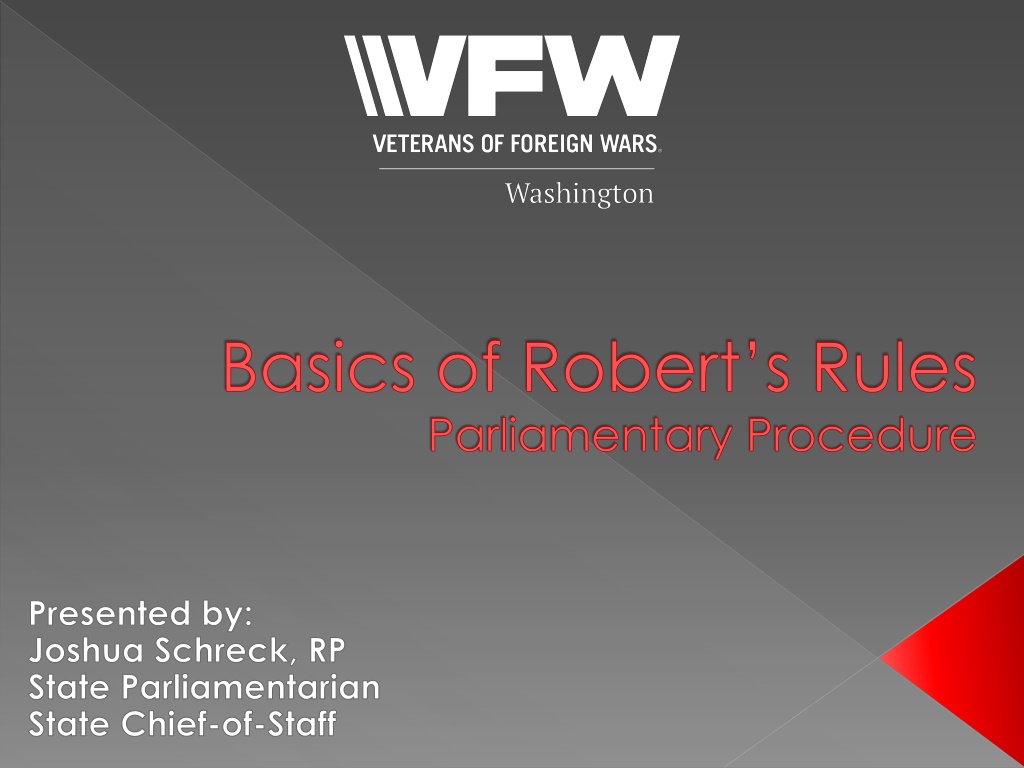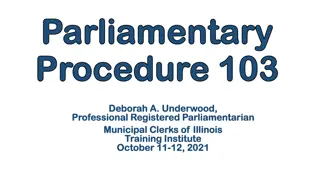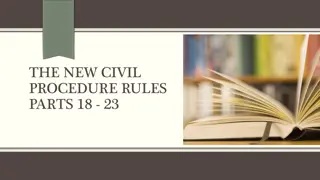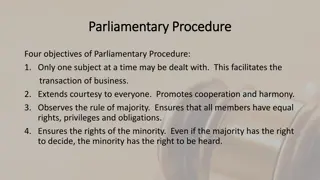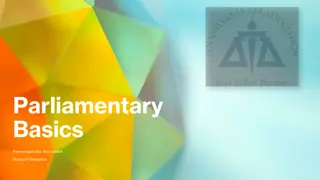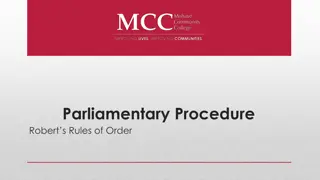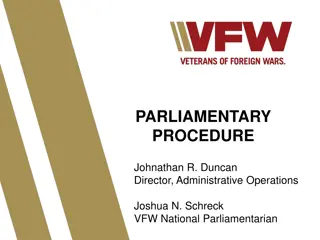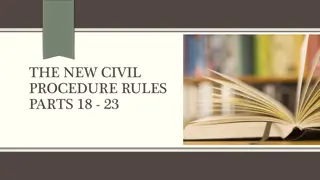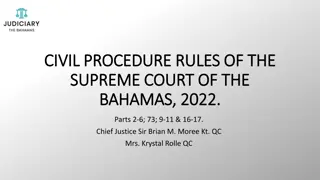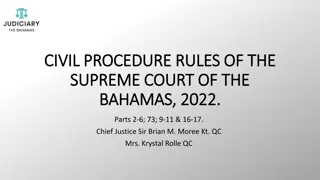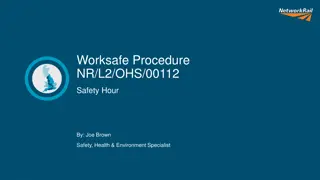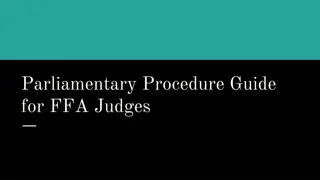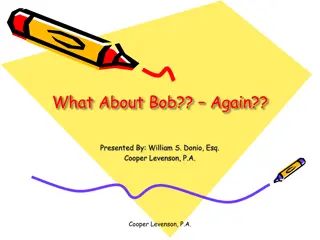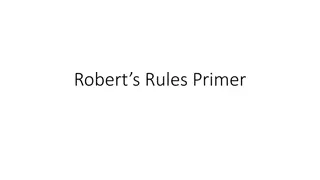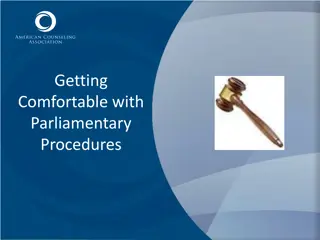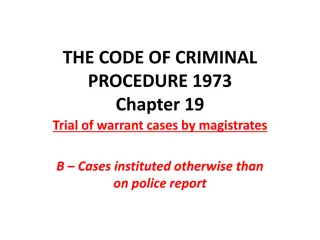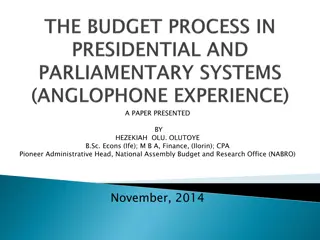Understanding Roberts Rules of Parliamentary Procedure
Learn the basics of Roberts Rules of Parliamentary Procedure, including the purpose, individual rights in meetings, the role of the chair, quorum requirements, and more. Discover how these rules can make meetings fair, efficient, and effective for various group sizes.
Download Presentation

Please find below an Image/Link to download the presentation.
The content on the website is provided AS IS for your information and personal use only. It may not be sold, licensed, or shared on other websites without obtaining consent from the author. Download presentation by click this link. If you encounter any issues during the download, it is possible that the publisher has removed the file from their server.
E N D
Presentation Transcript
Basics of Roberts Rules Parliamentary Procedure Presented by: Joshua Schreck, RP State Parliamentarian State Chief-of-Staff
Purpose Often seen as a hindrance to meetings More effective for larger meetings I.e. Districts, Departments or National May not be as effective in small meetings (Posts) If used properly it helps Make meetings fair by allowing everyone s voice to be heard Make meetings efficient by setting structure and time to the meetings
My Rights vs. Our Right Individuals have rights to attend, speak at and be an active participant in meetings Every member of a meeting has equal right to speak (whether new initiate or officers) Must balance rights of the organization to conduct business, thus the rules are in place May need to be a member of a committee National Bylaws Article II, Section 203
Its not that hard No one is meant to read ALL of RONR There are key things to understand in everyday meetings Practice is the best way of learning it
Silence is consent Not understanding parliamentary language = being mute
The Chair The person that runs meetings, calls the votes, and ensures adherence to an agenda Usually, the Commander Can be delegated to another member for the duration of a meeting (if Commander is absent) Refer to National Bylaws for who takes over in absence of usual chair Can be delegated to another member for segments of a meeting Chair must yield the chair Can be another officer, committee chair, etc Must yield chair back to regular chair when done
Quorum You need AT LEAST this many people to conduct business Ensures enough members are involved in decision making Posts Article II, Section 203: Post Bylaws may specify the minimum number At no time shall the quorum be less than 5 members physically present Districts Article IV, Section 403: Shall not be less than 1 delegate each from 50% of Posts in the District Departments Article V, Section 503: Not less than 1 delegate each from 10 Posts in the Department Department Bylaws may prescribe a different number National Article VI, Section 603: Shall be Delegates from a majority of all Departments Therefore, you do roll call Once established, it is maintained for the duration of the meeting, even if people leave (thus the concept of filibustering)
The meeting (Posts - Traditional) Opening ceremonies Recitation of Congressional Charter Calling the roll of officers Reading, referring, membership applications Report of Investigating Committee Balloting for applicants Mustering of recruits Reading of Minutes Quartermaster s Report Disbursements Receipts Reading of Bills Report of Service Officer Comrades in distress Remember our National Home Unfinished business New business Nominations, elections and installation of officers Good of the order Closing ceremonies
The meeting (Posts - Contemporary) Call to order Check dues cards Roll call of officers Read, refer membership applications Read minutes Quartermaster s report Report of Service Officer Comrades in distress Unfinished business New Business Good of the order Close meeting
The motion A motion is a call to action Can be a request to do something Can be a request to vote Can be a request to change something Essentially you are saying I think we should consider doing this
The Chart Can utilize a chart to assist with better understanding the quirks of different types of motions Requires (simple majority) to pass Requires 2/3 vote to pass Requires a second for consideration Debatable item Not a debatable item Amendable Chair determines if in order
Presenting an idea The main motion What you want to be done An actionable item that requires the group to decide on how to handle it A motion that affects the main motion is a secondary motion.
The second The second makes the motion important enough to discuss Eliminates unnecessary discussion on a point that only one member believes is worth discussing If at least one other person believes the motion is worth discussing, then they can put forth a second requiring action A second doesn t mean the person seconding agrees with the motion, but feels that it should at least be discussed Second can be made by any member, doesn t require recognition by the chair
Motions from Committee Since a committee consists of more than one person, a second is implied If a committee recommends adoption of a motion, then its clear a majority of that committee (i.e., multiple people) believe the motion should be discussed THEREFORE: A second is not required!! Common examples: Resolutions committee, legislative committee, committee reports, etc. The committee recommends adoptions and WE do so move
Discussion After a motion is made and seconded, it belongs to the group; it s on the floor The individual no longer has ownership of the motion They can not voluntarily withdraw They can not voluntarily change (thus why friendly amendments don t really exist) Once on the floor, any further changes or withdraw of motion must be done by consensus of the membership (see further motions)
Discussion Etiquette Any limits to discussion (time, number of times an individual can speak, total duration, etc) should be defined in advance and agreed upon by the group National Manual of Procedures Article X, Section 1001 (5): No more than 2 times, no longer than 10 minutes each time It is the duty of the chair to ensure discussion is orderly and relevant Individuals must be recognized by the chair before speaking Make sure discussion is directly related to the motion and its merits --- Germaine to the Motion Certain motions do not allow discussion (see chart) Most often these are procedural motions
Discussion Etiquette Often good to alternate pros & cons Helps to limit unnecessary discussion (i.e., if everyone agrees, you don t need 30 people defining why they agree if there is no dissent) Good for members to wait to speak a second time until all other interested members speak first Discussion should be directed towards the chair and not at other members Reduces assumption of direct attacks
Aye or No Once the chair has recognized there is no further discussion, they can call the vote For most motions, a result of >50% ayes of those voting passes a motion A member may call the question, however this needs to be in order and the member must be recognized by the chair Not meant to act as a way of limiting debate
Abstaining An abstention vote is the same as not voting, it doesn t count towards the final balloting in most cases Majority of those Present Majority of the Membership
Types of Votes Voice Votes Can be utilized for a vast majority of votes to speed along the meeting Chair makes decision on who is, essentially, the loudest If you believe they made the wrong call, any member may call for division This forces a hand count Hand or standing vote When called for aye or no, the person raises their hand or stands May be better for votes requiring 2/3 Ballot voting Mainly used for elections or any delegate strength voting Time consuming, limits utility
Making changes Motion to amend Secondary motion Changing the motion currently on the floor Usually changing the wording of the motion or intent of the motion Needs second, is debatable At this point debate is limited only to whether the proposed change should be made, not on the merit of the original motion itself Vote is only if the change should be made Has no effect on whether main motion is accepted I.e., voting on should we make this change not should we do this Amendments may only be made to the second degree I.e., you can propose a motion to amend (first degree) and a motion to amend the amendment (second degree), however these must be resolved prior to new motions coming to the floor. Once secondary motions to amend are made, discussion returns to the main motion At this point, new secondary motions may be made
Commit/Refer Motion to commit (or refer to committee) Referred Committee I move the motion be referred to a committee of five members (either by naming them or by appointment of the Regent) and the committee report back at the next chapter meeting Often used when its clear a motion hasn t been fully thought out Can be used when more details need to be laid out for the group to make an informed decision Motion must include the committee to which the motion will be referred and the proposed timeline for investigation Can be one that already exists (preferred) Can be to a special committee If this is recommended, need to provide specifics of the committee and its purpose
Postponement Can be used for multiple reasons You are running out of time and another more important item needs to be addressed You want to think about it more before deciding You don t want to deal with it right now Should not be used to avoid a vote or topic i.e., motion to postpone indefinitely Better to refer to committee or vote down Motion should include when the topic will be discussed Motion to postpone until the next business meeting
Division of a Question Allows a longer or complicated motion to be split into two or more parts Once approved, the motions must then be handled as two separate main motions to be handled in sequence No discussion on this one For example, you agree that something should be done, but not for the reasons put forth in a motion I move that the Post host a fundraising event on May 30th, 2022 as a fundraiser for the Relief Fund Motion to divide the question into First motion: I move the Post host a fundraising event on May 30th, 2022 Second motion: I move the fundraising event benefit the Relief Fund
Limiting Debate A right to discussion is an inherent part of participation in a meeting However, must balance rights of the group, therefore this requires a larger vote, 2/3 Ideally done in advance, such as in accepting standing rules, etc Various limits can be set, but motion must be specific Limit total number of times an individual speaks or for how long each person speaks Limit total time for discussion on a particular topic Since specifics are outlined, it is amendable
Calling the Question Purpose is to end debate and call the vote Call the question or I move the previous question can call this motion Needs to be in order as this would officially end debate Group should allow reasonable amount of time for discussion before this motion is called Can not call out or interrupt a speaker, must rise and be recognized formally by the chair
Question of Privilege Consider them complaints Often questions to ask for things interfering with your ability to participate in the meeting Do not need to be recognized by the chair as it is something that needs to be addressed imminently Most of the time deals with the setting of the meeting room itself Point of Privilege, can the chair have someone address the temperature in the room? Point of Privilege, there are people looking into the hall during the ritual, can we take care of that? Point of privilege, I am unable to hear the speaker, can they speak louder?
Adjourn Effectively ends the meeting If items are outstanding from the agenda, it gets put into unfinished business in the next meeting Can be used (judiciously) to force the end of a meeting Should only be used for this reason if there are time constraints, etc Most often used when the agenda is completed
Point of Order Calls the attention of the Chair to a potential breach of parliamentary procedure Chair decides whether to accept or reject your point If you disagree with the Chair s decision, you can appeal the decision of the Chair Chair then has to explain their ruling The group can then debate whether or not to sustain the chairs ruling and votes to sustain or overrule the chair Can be used if the chair makes a decision that conflicts with RONR They allowed a motion out of order, disregarded a motion that should have been considered, etc
Point of information Request's information or clarification to help decide on another motion Asking how much the Post budgeted for a given event Asking who can attend a proposed event, etc Asking what was done in previous years Can rise from seat, but should be acknowledged by the chair
Permission to Withdraw Requests a motion be withdrawn Chair will ask if anyone objects to the withdrawal of the motion Once a motion is seconded it belongs to the group, however, can be withdrawn as follows without a vote If no objections, it is withdrawn If there is even a single objection, there must be a vote to withdraw
Reconsider Can be moved at any point Not out of order, but the action is not taken until pending motions are finished Can only be called in the same meeting or the meeting immediately after the original vote Can only be moved by someone on the prevailing side of the original vote Someone who voted aye in a motion that won approval or no in a motion that failed to gain approval Prevents minority from constantly bringing up a dead point I move to reconsider the vote on the Post hosting the District meeting. I voted in favor of the motion If a motion to reconsider is approved, the Post addresses the previous question as a main motion
Nominations Nominations A nomination of an individual for an office doesn t require a second If no one else supports that person, they will simply lose the election
Summary Robert s Rules can be complex, but the basics are easy to follow Helps improve participation and efficiency if used properly Utilizing motion charts within meetings can help keep track of things Chairs should be familiar with the basics, parliamentarians should know it well Practice makes perfect
